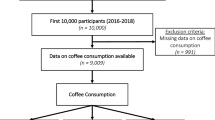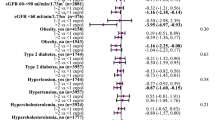Abstract
Although coffee is largely consumed by adults in Western countries, controversy exists about its impact on the cardiovascular system. We recently demonstrated that caffeinated and decaffeinated espresso coffee have different acute effects on endothelial function in healthy subjects, measured using flow-mediated dilation (FMD) of the brachial artery. In this study, we measured the anti-oxidant capacity of two coffee substances in terms of free stable radical 2,2-diphenyl-1-picryl-hydrazyl 50% inhibition (I50 DPPH). The caffeinated coffee had a slightly higher anti-oxidant capacity than decaffeinated espresso coffee (I50 DPPH: 1.13±0.02 vs 1.30±0.03 μl; P<0.001). We suggest that the unfavourable effects observed after caffeinated coffee ingestion are due to caffeine and that the antioxidant activity is responsible for the increased FMD observed after decaffeinated coffee ingestion. Further clinical and epidemiological studies are needed to understand the chronic effects of coffee consumption on health.
This is a preview of subscription content, access via your institution
Access options
Subscribe to this journal
Receive 12 print issues and online access
$259.00 per year
only $21.58 per issue
Buy this article
- Purchase on Springer Link
- Instant access to full article PDF
Prices may be subject to local taxes which are calculated during checkout

Similar content being viewed by others
References
Buscemi S, Verga S, Batsis JA, Donatelli M, Tranchina MR, Belmonte S et al. (2010). Acute effects of coffee on endothelial function in healthy subjects. Eur J Clin Nutr 64, 483–489.
Buscemi S, Verga S, Batsis JA, Tranchina MR, Belmonte S, Mattina A et al. (2009). Dose dependent effects of decaffeinated coffee on endothelial function in healthy subjects. Eur J Clin Nutr 63, 1200–1205.
Brand Williams W, Cuvelier ME, Berset C (1995). Use of a free radical method to evaluate antioxidant activity. Lebensm Wiss U Technol 28, 25–30.
Cimino F, Sulfaro V, Trombetta D, Saija A, Tomaino A (2007). Radical-scavenging capacity of several Italian red wines. Food Chem 103, 75–81.
Giovanelli G (2005). Evaluation of the antioxidant activity of red wines in relationship to their phenolic content. Ital J Food Sci 17, 381–393.
Klatsky AL, Koplik S, Kipp H, Friedman GD (2008). The confounded relation of coffee drinking to coronary artery disease. Am J Cardiol 101, 825–827.
Namdar M, Schepis T, Koepfli P, Gaemperli O, Siegrist PT, Grathwohl R et al. (2009). Caffeine impairs myocardial blood flow response to physical exercise in patients with coronary artery disease as well as in age-matched controls. PloS ONE 4, 1–6.
Parras P, Martỳnez-Tome M, Jimenez AM, Murcia MA (2007). Antioxidant capacity of coffees of several origins brewed following three different procedures. Food Chem 102, 582–592.
Author information
Authors and Affiliations
Corresponding author
Ethics declarations
Competing interests
The authors declare no conflict of interest.
Rights and permissions
About this article
Cite this article
Buscemi, S., Batsis, J., Arcoleo, G. et al. Coffee and endothelial function: a battle between caffeine and antioxidants?. Eur J Clin Nutr 64, 1242–1243 (2010). https://doi.org/10.1038/ejcn.2010.137
Received:
Revised:
Accepted:
Published:
Issue Date:
DOI: https://doi.org/10.1038/ejcn.2010.137
Keywords
This article is cited by
-
Coffee consumption and risk of hypertension in the Polish arm of the HAPIEE cohort study
European Journal of Clinical Nutrition (2016)
-
Association of daily coffee and tea consumption and metabolic syndrome: results from the Polish arm of the HAPIEE study
European Journal of Nutrition (2015)



